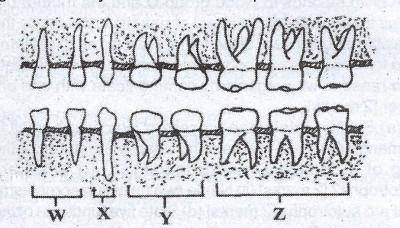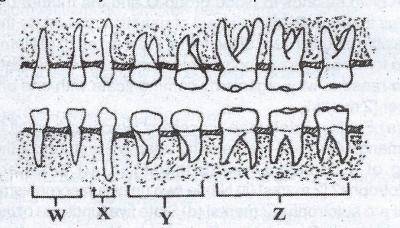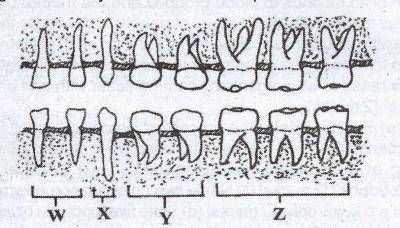Year :
2017
Title :
Biology
Exam :
WASSCE/WAEC MAY/JUNE
Paper 1 | Objectives
21 - 30 of 49 Questions
| # | Question | Ans |
|---|---|---|
| 21. |
Which of the following types of placentation is not common amongst syncarpous pistils? A. Marginal B. Axile C. Parietal D. Free central |
A |
| 22. |
The complex energy-rich organic matter which living organisms need for life is A. water B. air C. food D. mineral salts |
C |
| 23. |
Which of the following processes are associated with photosynthesis? I. Energy from sunlight is absorbed II. Carbon dioxide is evolved III. Oxygen is given off IV. Glucose is synthesized A. I and II only B. I, II and IV only C. I, III and IV only D. I, II, III and IV |
C |
| 24. |
Which of the following function is associated with calcium in plants? Formation of A. cell wall B. ribosomes C. proteins D. cell membrane |
A |
| 25. |
 The diagram above shows the dentition of an organism. What organism is this? A. rabbit B. cat C. frog D. man |
D |
| 26. |
 The diagrams below show the dentition of an organism. The function of the teeth labelled X is for A. biting and grasping B. chewing and grinding C. tearing and grasping D. chewing and tearing Detailed Solution-Canines are effectively the corners of the mouth and perform the function of ripping and tearing food.- meant for ripping and tearing food. |
|
| 27. |
 The teeth which are absent in the young of the organism whose dentition is shown above is labelled A. W B. X C. Y D. Z |
D |
| 28. |
The number of individuals that the environment can support over a long period of time is its A. growth rate B. total capacity C. population capacity D. carrying capacity |
C |
| 29. |
A good site for secondary succession would be A. a sand dune B. a bare rock C. a land that has just had forest fire D. a stretch of barren land |
C |
| 30. |
A population which exceeds its carrying capacity and then collapses is represented graphically by a A. bell-shaped curve B. linear curve C. sigmoid curve D. skewed curve |
A |
| 21. |
Which of the following types of placentation is not common amongst syncarpous pistils? A. Marginal B. Axile C. Parietal D. Free central |
A |
| 22. |
The complex energy-rich organic matter which living organisms need for life is A. water B. air C. food D. mineral salts |
C |
| 23. |
Which of the following processes are associated with photosynthesis? I. Energy from sunlight is absorbed II. Carbon dioxide is evolved III. Oxygen is given off IV. Glucose is synthesized A. I and II only B. I, II and IV only C. I, III and IV only D. I, II, III and IV |
C |
| 24. |
Which of the following function is associated with calcium in plants? Formation of A. cell wall B. ribosomes C. proteins D. cell membrane |
A |
| 25. |
 The diagram above shows the dentition of an organism. What organism is this? A. rabbit B. cat C. frog D. man |
D |
| 26. |
 The diagrams below show the dentition of an organism. The function of the teeth labelled X is for A. biting and grasping B. chewing and grinding C. tearing and grasping D. chewing and tearing Detailed Solution-Canines are effectively the corners of the mouth and perform the function of ripping and tearing food.- meant for ripping and tearing food. |
|
| 27. |
 The teeth which are absent in the young of the organism whose dentition is shown above is labelled A. W B. X C. Y D. Z |
D |
| 28. |
The number of individuals that the environment can support over a long period of time is its A. growth rate B. total capacity C. population capacity D. carrying capacity |
C |
| 29. |
A good site for secondary succession would be A. a sand dune B. a bare rock C. a land that has just had forest fire D. a stretch of barren land |
C |
| 30. |
A population which exceeds its carrying capacity and then collapses is represented graphically by a A. bell-shaped curve B. linear curve C. sigmoid curve D. skewed curve |
A |